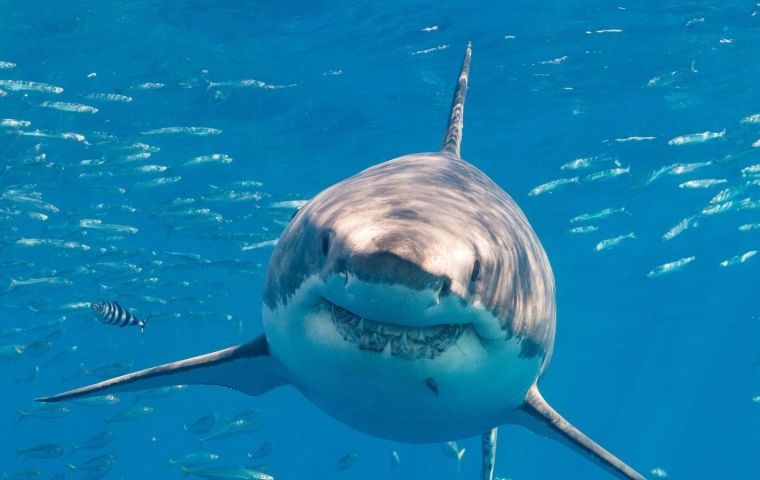MercoPress. South Atlantic News Agency
Large amounts of cocaine found in Brazilian sharks
 Further studies are needed to determine whether the cocaine found in marine animals can have negative effects on human health
Further studies are needed to determine whether the cocaine found in marine animals can have negative effects on human health Researchers at the Rio de Janeiro-based Oswaldo Cruz Foundation (Fiocruz) found traces of cocaine in 13 sharks of the species Rhizoprionodon lalandii, popularly known as tubarão-bico-fino-brasileiro, cação rola rola or cação-frango, according to a study in the appearing this week in the journal Science of The Total Environment, Agencia Brasil reported Tuesday.
The Fiocruz investigators were shocked by the amount of narcotics discarded through sewage pipelines. Cocaine's main metabolite -benzoylecgonine- was found in 12 of the specimens.
The material was collected in Recreio dos Bandeirantes, a neighborhood in west Rio de Janeiro, between September 2021 and August 2023 during an investigation to monitor changes in the environment, both naturally and man-caused.
“In Brazil, studies have already detected the contamination of water and some small aquatic beings by cocaine, such as Mexican mussels. Our analysis is the first to find the substance in sharks,” said pharmacist Enrico Mendes Saggioro, one of the study's leaders alongside biologist Rachel Ann Hauser-Davis, both from Fiocruz's Laboratory of Environmental Health Assessment and Promotion.
According to Hauser-Davis, sharks play an important role in the marine ecosystem, as do rays. As predators, they are leading figures in the food chain and are assumed as sentinel species for the detection of environmental damage, including different forms of pollution.
The Fiocruz Laboratory has issued several important environmental alerts from studies that identified the contamination by methane in fish of Rio Doce, in Espírito Santo, after the collapse of the Samarco mining company's dam; and in canals and rivers collected in Rio de Janeiro.
The 2024 World Drug Report released by the United Nations Office on Drugs and Crime (UNODC), placed Brazil among the world's largest consumers of cocaine. Studies indicate that the main way for the drug to reach the marine environment is through the discarding of residues of the substance in the waste thrown into the sea.
Mendes Saggioro explained that from this finding the research group decided to investigate whether the animals that the laboratory had collected for studies involving other contaminants were also filled with cocaine. ”The result is impressive. We found the substance in all 13 samples (3 males and 10 females) analyzed and only one of them did not test positive for benzoylecgonine.“
Benzoylecgonine was detected in 12 muscle samples and in two liver samples. The average concentration of cocaine in the animals was three times higher than the concentration of the metabolite. One hypothesis is the overexposure of the animals to the substance. Another finding intriguing the specialists was the higher concentration of cocaine in the muscles than in the liver.
Saggioro explained that the shark's liver is a metabolizing organ, as in humans. ”Everything that is ingested is transformed by the liver and then excreted. To our surprise, cocaine was found in higher concentration in muscle, which is a tissue of accumulation, which may indicate the abundance of the substance's presence in the marine environment. The sharks would be contaminated (...) either by inhabiting the region or by feeding on other contaminated animals,” the expert conjectured.
Hauser-Davis added that the team now intends to collect and analyze samples of water and other animals from this and other regions of the coast of Rio de Janeiro.
The samples were analyzed at the Advanced Laboratory Section of Santa Catarina (SLAV/SC), a unit linked to the National Agricultural Laboratory of Rio Grande do Sul, which is part of the National Network of Agricultural Laboratories of the Agriculture Ministry.
Hauser-Davis also insisted on the need for specific studies to be carried out to determine the external consequences of this contamination on animals. She believes that there may be an impact on growth, maturation, and, especially, on shark fecundity, since the liver acts on embryo development. The analyzed species lives near the coast and does not have migratory characteristics, which lead researchers to believe that they were contaminated off the coast of Rio de Janeiro, where the west zone is the fastest growing area as well as the most populated, with nearly 3,000,000 inhabitants, according to the 2022 census.
The two scientists advocate that new studies be carried out to answer whether the cocaine found in marine animals can have negative effects on human health. Recent research by the Federal University of São Paulo and Santa Cecília University, in São Paulo, showed high concentrations of cocaine in the water of Santos Bay, indicating that the drug can cause problems in the cells and genetic material of fish.
“Pollution and environmental contamination directly affect animals and nature, and also impact, in one way or another, human life. The health of one is linked to the health of the other,” they explained.




Top Comments
Disclaimer & comment rulesCommenting for this story is now closed.
If you have a Facebook account, become a fan and comment on our Facebook Page!